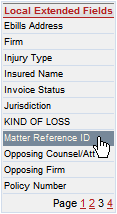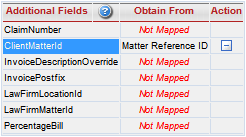|
Although eBillingHub pulls basic invoice information (such as matter number, invoice number, fees and expenses) from your Time and Billing system, many clients require additional information. The Map Client Extended Fields screen lets you indicate what User Defined Field (UDF) in your Time and Billing system contains the additional information needed for an eBillingHub extended field required by a client.
Extended fields vary by client. Some extended fields are optional, either because the client's billing requirements indicate the field is optional, or because it is intended to override a default value. The ClientMatterId field is the most common extended field, and is almost always required. The other extended fields are almost always optional. If you are not sure if an extended field is required, leave it unmapped and run an invoice for this client through the Billing Wizard. Then check the Validation Report for any validation errors related to missing fields.
To map extended fields for a client, follow these steps:
1. Click the Map Client Extended Fields option on the Client Setups screen to display the Map Client Extended Fields screen.
2. Select a client from the list on the left by clicking on its name. (This list includes all clients from your Time and Billing system that are mapped to an eBillingHub supported client.)

This action displays a list of the eBillingHub extended fields (shown in the Additional Fields column) required by this client. Fields that are already mapped show a local extended field name in the Obtain From column. (Local Extended Fields are the UDFs from your Time and Billing system that eBillingHub uses to extract data for the extended fields.) Fields without a mapping display "Not Mapped".
As you hover the cursor over a field name, eBillingHub displays whether the field applies at the client or matter level. To view additional information about these fields, click the question mark icon .png) . .
.png)
3. Select an extended field in the Additional Fields column that you want to map (or change its existing mapped value). You only need to select the fields you currently use.
4. Select a UDF from the Local Extended Fields list that will be used by eBillingHub to supply the information for the client's extended field. Use the Page links to browse through this list.

The UDF you select is then populated in the Obtain From column of the Additional Fields list. In the example shown, ClientMatterId has been mapped to Matter Reference ID. To delete a mapping, click the Clear icon  in the Action column. in the Action column.

5. Continue mapping other client extended fields if desired. When done, click Save to save your extended fields map.
For instructions on using the Copy and Paste tools to copy an extended fields map from one client to another, see Related Topics.
Related Topics
.png) How to Copy an Extended Fields Map How to Copy an Extended Fields Map
.png) Mapping Clients Mapping Clients
.png) Mapping Expense Codes and Timekeeper Title Codes Mapping Expense Codes and Timekeeper Title Codes
.png) Editing Extended Fields Editing Extended Fields
|